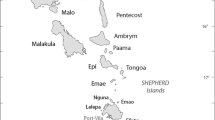Summary
The diversity of cassava was studied in 10 communities spanning a range of socio-economic circumstances and located in the four main agro-ecological zones in Ghana. On average, each farmer grew about two cultivars, mostly landraces, both for home consumption and sale of the storage roots. In total, 35 differently-named landraces were mentioned, 26 in only single communities. Most communities had grown cassava for > 100 years and seem to have acquired an additional landrace about every decade. Landraces were also abandoned. The attributes mentioned of newly-acquired landraces were generally the reverse of landraces abandoned and most were related to the storage roots. All the current landraces in all the communities seem to have been obtained from other communities. None of the almost 300 interviewed farmers understood the role of pollination in setting seed and providing variation amongst seedlings, none purposely planted seeds and most farmers ignored or weeded out cassava seedlings. However, some did use planting material (stem cuttings) from self-sown seedlings, often when planting material from their crops was scarce, and some purposely grew cuttings from a few such seedlings, apparently as experiments. That many seedlings were both reported and seen in newly-planted crops suggests that some may be accidentally used as planting material, especially those seedlings that are perceptually indistinct from the planted crop, resulting in polyclonal landraces.
Similar content being viewed by others
References
Adams, C.D., 1957. Activities of Danish Botanists in Guinea by R. Addo-Fening (Ed.), 1738–1850. Transactions of the Historical Society of Ghana III. Part 1.
Boster, J.S., 1984. Classification, cultivation and selection of Aguaruna cultivars of Manihot esculenta (Euphorbiaceae). Adv Econ Bot 1: 34–47.
Boster, J.S., 1985. Selection for perceptual distinctiveness: Evidence from Aguaruna cultivars of Manihot esculenta. Econ Bot 39: 310–325.
COSCA, 1999. Cassava Production in Ghana: A function of market demand and farmer access to improved production and processing technologies. Report No. 21. International Institute of Tropical Agriculture, Ibadan, Nigeria.
De Waal, D., F.R. Chinjinga, L. Johansson, E.F. Kanju & N. Nathaniels, 1997. Village-based cassava breeding in Tanzania. In: L. van Veldhuizen, A. Waters-Bayer & R. Ramirez (Eds.), Farmers' Research in Practice: Lessons from the Field. pp. 83–88. International Technology Publications (UK).
Doku, E.V., 1969. Cassava in Ghana, p. 44. Ghana University Press, Accra.
Elias, M. & D. McKey, 2000. The unmanaged reproductive ecology of domesticated plants in traditional agroecosystems: An example involving cassava and a call for data. Acta Oecologica 21: 223–230.
Elias, M., D. McKey, O. Panaud, M.C. Anstett & R. Thierry, 2001a. Traditional management of cassava morphological and gene diversity by the Makushi Amerindians (Guyana, South America): Perspectives for on-farm conservation of crop genetic resources. Euphytica 120: 143–157.
Elias, M., L. Penet, P. Vindry, D. McKey, O. Panaud & T. Robert, 2001b. Unmanaged sexual reproduction and the dynamics of genetic diversity of a vegetatively propagated crop plant, cassava (Manihot esculenta Crantz), in a traditional farming system. Mol Ecol 10: 1895–1907.
Fukuda, W.M.G. & N. Saad, 2001. Participatory research in cassava breeding with farmers in Northern Brazil. PRGA, Program, Colombia. Embrapa, July 2001. http://www.searice.org.ph/online library/index.asp.
FAOSTAT, 2004. http://apps.fao.org/.
Gibson, R.W., S.C. Jeremiah, V. Aritua, R.P. Msabaha, I. Mpembe & J. Ndunguru, 2000. Sweet potato virus disease in sub-Saharan Africa: Evidence that neglect of seedlings in the traditional farming system hinder the development of superior resistant landraces. J Phytopathol 148: 441–447.
Jones, W.O., 1959. Manioc in Africa, p. 315. Food Research Institute, Stanford University, USA.
Korang-Amoako, S., R.A. Cudjoe & E. Adams, 1990. Biological control of cassava pests in Ghana. Prospects for the integration of strategies. In: S.K. Hahn & F.E. Caveness (Eds.), Integrated pest management for tropical root and tuber crops: Proceedings of the workshop on the global status and prospects for integrated pest management of root and tuber crops in the tropics, 25–30 October, 1987, Ibadan, Nigeria. International Institute of Tropical Agriculture, Ibadan, Nigeria, xii + 235 pp.
Lamb, E.M. & L.L. Hardman, 1985. Final Report of: Survey of Bean Varieties Grown in Rwanda. January 1984 to June 1985. AID-Rwanda Local Crop Storage Cooperative Research, p. 160.
Ministry of Food and Agriculture, Ghana, 1997. A Case Study for Cassava Development in Ghana. International Fund for Agricultural Development (IFAD), Rome, Italy, p. 40.
Manu-Aduening, J.A., 2004. Participatory breeding for superior mosaic-resistant cassava in Ghana. Ph.D. Thesis. N.R.I., University of Greenwich, UK. p. 346.
Oslen, K.M. & B.A. Schaal, 1999. Evidence on the origin of cassava: Phylogeography of Manihot esculenta. Proceeding of the National Academy of Sciences USA 96: pp. 5586–5591.
Pujol, B., G. Gigot, G. Laurent, M. Pinheiro-Kluppel, M. Elias, M. Hossaert-McKey & D. McKey, 2002. Germination ecology of cassava (Manihot esculenta Crantz, Euphorbiaceae) in traditional agroecosystems: Seed and seedling biology of a vegetatively propagated domesticated plant. Econ Bot 56: 366–379.
Salick, J., N. Cellinese & S. Knapp, 1997. Indigenous diversity of cassava: Generation, maintenance, use and loss among the Amuesha, Peruvian Upper Amazon. Econ Bot 51: 6–19.
Sambatti, J.M.B., P.S. Martins & A. Ando, 2001. Folk taxonomy and evolutionary dynamics of cassava: A case study in Utotuba, Brazil. Econ Bot 55: 93–105.
Voss, J., 1992. Conserving and increasing on-farm genetic diversity: Farmer management of varietal bean mixtures in Central Africa. In: J.L. Moock & R.E. Rhoades (Eds.), Diversity, Farmer Knowledge and Sustainability, pp. 34–54. Cornell University Press, Ithaca.
Author information
Authors and Affiliations
Corresponding author
Rights and permissions
About this article
Cite this article
Manu-Aduening, J.A., Lamboll, R.I., Dankyi, A.A. et al. Cassava diversity in Ghanaian farming systems. Euphytica 144, 331–340 (2005). https://doi.org/10.1007/s10681-005-8004-8
Received:
Accepted:
Issue Date:
DOI: https://doi.org/10.1007/s10681-005-8004-8




